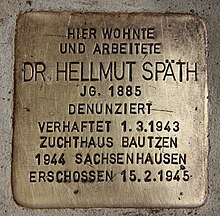Hellmut Späth
Hellmut Ludwig Späth (born December 4, 1885 in Paris ; † February 15, 1945 in Sachsenhausen concentration camp ) was a German tree nursery owner. He was the last owner of the Späth tree nurseries in Berlin .
Career
Späth was born the son of the Berlin tree nursery owner Franz Späth and his first wife. He attended Schulpforta boarding school , where he graduated from high school. He then studied botany , geology , economics and philosophy, first in Berlin and then in Cambridge . In 1910 he returned to Berlin and received his doctorate there in 1912 at the Agricultural University . His dissertation was published by Paul Parey in Berlin in 1912 under the title Der Johannistrieb. A contribution to the knowledge of the periodicity and growth ring formation of deciduous woody plants . In this work he was the first to describe the development of side shoots when the mother axis grew in length without going through a bud stage, and he coined the term syllepsis for this phenomenon.
In the same year 1912, his father transferred the family business in Berlin-Baumschulenweg to him , which he expanded between 1920 and 1930 into what was then the largest tree nursery in the world, employing up to 1,500 people.
In 1920 he married Helga Eysler, a Jew. Their daughter, who later became a West Berlin journalist and TV presenter, Dagmar Späth , was born in 1922. In 1926 the couple divorced. Späth married twice more, and these marriages were divorced each time.
With the global economic crisis , the tree nursery got into economic difficulties, which is why Späth had to sell land.
After the seizure of power , Späth joined the NSDAP in 1933 for the benefit of his company . The advantages were direct contact with those in power, who resulted in orders for the greening of motorways and the design of the Berlin Olympic Stadium and Tempelhof Airport . Competitors and envious people denounced Späth, who worked with "Jewish capital", continued to employ Jews and cultivated his friendship with Werner Magnus , a botanist who had lost his professorship at Berlin University as a Jew . Späth's daughter Dagmar from her first marriage to Helga Eysler was " half-Jewish " according to the National Socialist definition . She had to leave school in 1940, to which Spath objected.
In 1943, that made Gestapo Späth private secretary Erna Wisniewsky to her -person V . This provided information that convicted Späth of the prohibited barter trade. He was taken into protective custody on March 1, 1943 for “war economic offenses” and imprisoned in Bautzen. In the protective custody warrant, Ernst Kaltenbrunner stated that Späth was endangering “the existence and security of the people” by doing the greatest possible damage to the people and the empire through hidden agitation and rooting out work. On August 13, 1943, Späth was sentenced to one year in prison. The NSDAP excluded him because his "character attitude" was not only "not the same as that of the National Socialist, but opposed to it". After serving his sentence in the Bautzen II prison, the Gestapo transferred him to the Sachsenhausen concentration camp .
When the SS carried out a mass murder of the prisoners in the Sachsenhausen concentration camp on February 15, 1945, Späth was probably one of the victims. The SS named diarrhea and catarrh as the cause of death on the death certificate.
Afterlife and remembrance
The Soviet Military Administration in Germany (SMAD) did not recognize Späth as a Nazi victim. Späth was considered a “staunch Nazi” and the company was confiscated in 1947 and made public in 1949 . After the reunification, Späth's heirs requested the transfer back. The Treuhandanstalt refused to do so on the grounds that the expropriation by the SMAD was legal because Späth was a "chief Nazi". When the Treuhand stuck with it in court, it suffered a defeat in 1997 that amounted to a rehabilitation of Späth.
On August 17, 2009, a stumbling stone memorial was laid in front of the main portal of the Pforta state school in Schulpforte . Späth was a student at this school.
Another stumbling block has been laid on a staircase leading to the administration building and Hellmut Späth's former home within the grounds of the Späth'sche tree nursery.
Others
A Floribunda rose cultivation that was grown in the nursery in 1936 and marketed in 1936 was named by Späth in honor of his daughter Dagmar Späth .
literature
- Heinrich-Wilhelm Wörmann: Resistance in Köpenick and Treptow (= Volume 9 of the series of publications on the resistance in Berlin from 1933 to 1945), German Resistance Memorial Center, Berlin 1995, p. 237.
- Robert Volz: Reich manual of the German society . The handbook of personalities in words and pictures. Volume 2: L-Z. German business publisher, Berlin 1931, DNB 453960294 .
Individual evidence
- ↑ Frauke Böger: Consequences of a suspicion . In: The daily newspaper of September 17, 2010.
- ↑ U. Kulke: Nurseries - from the first edition on . Berliner Morgenpost, May 8, 2005, accessed on September 11, 2019.
- ↑ All quotations from Frauke Böger: Consequences of a suspicion. In: The taz. dated September 17, 2010.
- ↑ Albrecht Günther: Stolpersteine admonish against forgetting In: mz-web.de (Mitteldeutsche Zeitung) of August 17, 2009. Retrieved on July 11, 2010.
| personal data | |
|---|---|
| SURNAME | Late, Hellmut |
| ALTERNATIVE NAMES | Späth, Hellmut Ludwig (full name) |
| BRIEF DESCRIPTION | German tree nursery owner |
| DATE OF BIRTH | 4th December 1885 |
| PLACE OF BIRTH | Paris |
| DATE OF DEATH | February 15, 1945 |
| Place of death | Sachsenhausen concentration camp |

